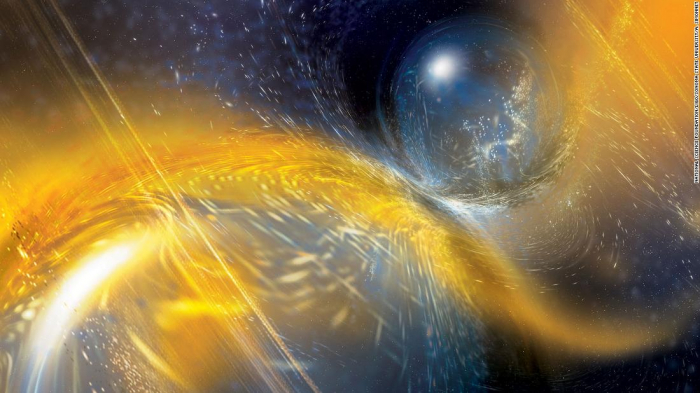But the two neutron stars that collided are more massive than all known binary star pairs. They collided 520 million light-years away, so the gravitational waves are just now reaching us even though they occurred millions of years ago.
Astronomers announced the discovery at the 235th annual meeting of the American Astronomical Society in Honolulu Monday, and said this finding challenges theories about how neutron star pairs form and merge.
On April 25, 2019, the Laser Interferometer Gravitational-wave Observatory, or LIGO, in Livingston, Louisiana picked up on the telltale signal of gravitational waves in space.
At first, they weren't sure what caused it and were torn between three scenarios: the never-before-seen collision of a neutron star and a black hole; a collision between two massive neutron stars; or three potential black hole mergers.
The first detection of gravitational waves created by a neutron star collision was made in August 2017. It was the first time that gravitational waves, heavy metals like gold and platinum and light were all observed in the same event.
While no light was detected in the April 2019 collision, researchers knew that objects with unusually high mass created it.
"From conventional observations with light, we already knew of 17 binary neutron star systems in our own galaxy and we have estimated the masses of these stars," said Ben Farr, study co-author and LIGO team member based at the University of Oregon. "What's surprising is that the combined mass of this binary is much higher than what was expected."
The team's study has been submitted to The Astrophysical Journal Letters.
The LIGO detector was part of an international collaboration that spotted the first signal of gravitational waves on February 16, 2016, and the first observed neutron star collision in 2017.
This kicked off a new field of astronomy involving gravitational waves.
Neutron stars are the smallest in the universe, the remnants of supernovae. Their diameters are comparable to the size of a city like Chicago or Atlanta, but they are incredibly dense, with masses bigger than that of our sun. So think of the sun, compressed into a major city -- and then think of two of them violently crashing into each other.
The astronomers revealed that the combined mass of both neutron stars is 3.4 times the mass of our sun. But the known neutron star pairs in our galaxy only reach about 2.9 times the mass of the sun.
The researchers said they can't rule out the possibility that the other object in the collision was a black hole, or some other exotic, unknown type of collision. Black holes are heavier than neutron stars, but in this particular scenario the black hole would have to be incredibly small.
Based on the data, the researchers feel confident that this collision occurred between two unusually large neutron stars.
Pairs of neutron stars form when two massive stars in a binary system come to the end of their lives. Other times, neutron stars that formed separately from one another come together in orbit in a dense, star-filled environment.
Now, astronomers have to unravel the mystery of how this particularly high mass system formed.
"This leads to the intriguing possibilities that the old binary system we've discovered formed differently to those observed in the Milky Way, and that neutron star binaries this massive may not be detectable by current telescope surveys," said Susan Scott, study co-author from the Australian National University.
CNN
















































